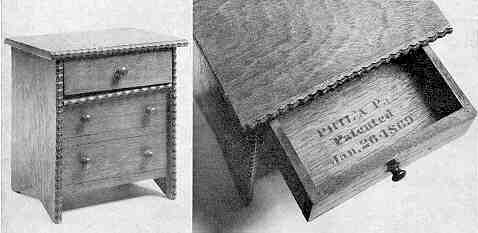Bureau Bank (Serrill Patent)
Freedmens Bureau Bank
Give Me A Penny Bank
PART I
by F.H. Griffith - HOBBIES Magazine - May, 1967

There is a group of mechanical banks whose operation is based on the principle of a trap door effect, in that they all have in common a drawer with a tilting or false bottom. The majority of these banks are made of wood, however, there are several made of cast iron. The most interesting of this specific group are those made of wood, and these include the Bureau or Chest Bank in several types, the two different types of the Trick Savings Bank, Bureau Bank (Serrill Patent), Give Me A Penny Bank, and the Freedmens Bureau. Those in metal are the Chandlers Bank and the Presto Bank.
At present we are concerned with the three best of those made of wood, and these are Give Me A Penny Bank, Bureau (Serrill Patent), and the Freedmens Bureau. It is sort of a toss-up as to the numerical ranking of these three banks. There are those who prefer the Give Me A Penny with its interesting added action of the rising picture, then others would lean toward the Freedmens Bureau with its close alliance to the Freedman’s Bank. Last, and certainly not least, is the Bureau (Serrill Patent) which has the distinction of being the earliest known patented, dated mechanical bank. This bank is our choice as No. 155 in the numerical classification, and in order, the Freedmens Bureau No. 156, and Give Me A Penny No. 157. Undoubtedly there will be individuals who will not agree with the order of the ranking of these three banks. However, it is not earth-shaking one way or the other as each is a very fine bank in itself and any one could be ahead of the other two with some justification in each case.
The Bureau (Serrill Patent) was patented February 16, 1869 by James Serrill of Philadelphia, Pa. So there will be no confusion as to the date of January 26, 1869 as shown on the bank, please note the patent itself states as follows: "Letters Patent #87,006 dated February 16, 1869; antedated January 26, 1869." This bank then is the earliest known patented mechanical bank. (Hall’s Excelsior usually placed in this position was patented December 21, 1869, a little over ten months later, since it was antedated December 7. Keep in mind, of course, that Hall’s Excelsior is the earliest known patented cast iron mechanical bank.) Mr. Serrill, in the patent papers, refers to his toy money box as a bureau and specifies the name "The Magic Savings Bank." To the best of the writer’s knowledge, however, this name was not used in connection with the bank when it was commercially produced, nor does it appear on the bank itself. It is interesting to note that Serrill’s name is spelled in two different ways in the patent, Serrill and Serrell.
The bank shown, Figure 1 and Figure 2, is in fine original condition and is in the extensive collection of Leon Perelman of Philadelphia, Pa. He purchased the bank some years ago from an antique dealer in Sanatoga, Pa. Figure 1 pictures the bank with the workable top drawer in the closed position. The two lower drawers are representations and do not open. Figure 2 shows the top drawer open with part of the stenciled wording showing on the bottom of the drawer. This reads as follows: "Phil’a Pa Patented January 26-1869." Above this wording (the photographer was unable to focus this properly) appears "Jas. Serrill Patentee." The bank is finished like a piece of walnut or mahogany furniture, varnished and so on.
The operation of the bank is simple. The top drawer is pulled open and a coin is placed therein. The drawer is closed and upon reopening the coin has disappeared. This is caused by the tilting bottom of the top drawer. It is constructed in such fashion that the bottom of the drawer drops down at the back when it is in the closed position. This cannot be detected when the drawer is open since it immediately raises back up into normal position when the drawer is pulled forward. It’s really very simple action but quite clever and rather puzzling to those who are not familiar with the operation.
It bears mention in concluding on the Bureau Bank (Serrill Patent) that the patent papers include coverage of a cloth bag-like effect for the inside of the bank, into which coins would drop after sliding from the drawer bottom. Although not stated in the patent, this could have had a possible deadening effect on the sound made by the coins dropping into the bank.
(To be continued in the June Issue)
